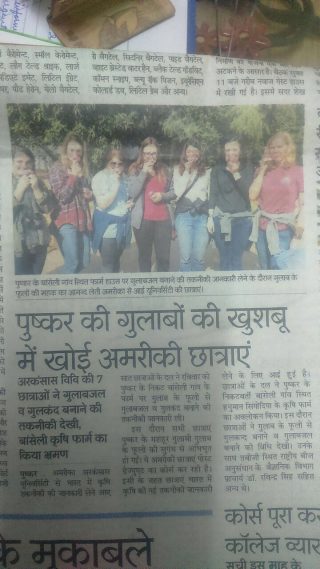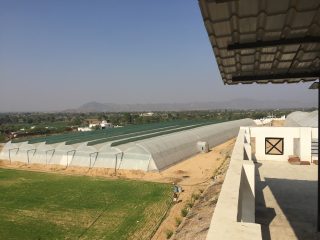On the morning of January 7th, we began the day with a short drive to Pushkar to visit a rose processing factory. Upon arrival we were greeted with a drumbeat welcome and a shower of flower petals like we’d had at the Nadi village. Our host and translator was the same as the day before, Dr. Ravindra Singh. He explained all the industries that went on at this site before we got to explore them all. Two things went on inside the processing building -in one big open room women separate out the petals from the flowers and dry them. In the next room women work on rose jam: mixing the ingredients (roses and sugar), rotating the batches between sealed and open containers, and sorting through the jam for any leaves that could’ve gotten through to the final product.
Another part of the site was a nursery where some ornamentals and many types of fruit trees were grown to be sold to farmers in the region. The last section we visited was really fascinating – rose oil was being made in big clay pots. The rose petals have a high moisture content and the process we saw was distilling all the moisture content into rose oil. Hot air was blown through bamboo pipes into the clay pots, and the pots were soaked in cool water to promote steaming and speed up the process.
After our tour we were ushered into an office and we got to sample lots of products made with rose – rose perfumes and rose water and a couple types of rose jam. We were also able to sample gooseberry candies – some of us had tried the bitter fruits the day before so it was nice to taste the sweet counterpart. We had an opportunity to buy perfumes and rose water and we all posed with some blooms for a journalist from the local paper.
We carried a strong smell of rose with us when we got back on the bus and went to our next site – a huge greenhouse complex at Govindgarh farm. Dr. Singh was our guide here as well.
We learned about the methods of temperature control in the greenhouses: how the side panels can be rolled up to offer ventilation and work with sprinklers to aid in evaporative cooling, which is very important in summer months when temperatures increase. We also saw how they efficiently used their space by having the cucumbers climb up strings hung from the ceiling instead of taking up more horizontal space. Other greenhouses grew tomatoes and bell peppers. We were all impressed by their water management – how they monitored soil moisture, used drip irrigation, and captured rainwater that ran off the greenhouses. I had never seen a system like they were using to add bacterial cultures and nutrients to the water before they irrigated with it. In some places they were growing cilantro plants along with the cucumbers to be even more efficient with the space.
I was very impressed with their management and especially how they conserved large amounts of energy by limiting their operations in the summer to a smaller nursery area. This way they wouldn’t need to cool the whole facility. The greenhouses also allowed them to sell their produce early and late in the season so as to not compete with other farmers. In the peak growing season the facility employed lots of pickers because there is such a high density of crops all producing. Dr. Singh told us the facility took a short time to pay for itself and I feel like this type of efficient, contained seasonally-independent growing facility is where agricultural practices could be trending for many types of crops.


